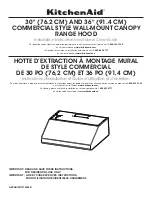
9
Complete Preparation
1.
Determine the required height for the home power supply
cable and drill a 1¼" (3.2 cm) hole at this location.
2.
Run the home power supply cable according to the National
Electrical Code or CSA Standards and local codes and
ordinances. There must be enough 1/2" (1.3 cm) conduit and
wires from the fused disconnect (or circuit breaker) box to
make the connection in the hood’s electrical terminal box.
NOTE:
Do not reconnect power until installation is complete.
3.
Remove the grease filters. See the “Range Hood Care”
section.
4.
Remove terminal box cover and set aside.
5.
Remove knockout from the top of the vent hood and install a
UL listed or CSA approved 1/2" (1.3 cm) strain relief.
Install Range Hood
1.
Depending on your installation, remove either top or rear
rectangular vent knockout.
2.
Remove tape from damper flap.
NOTE:
The 3¼" x 10" (8.3 x 25.4 cm) rectangular damper
can be installed up to 1" (2.5 cm) on either side of the hood
center to accommodate off center duct work.
3.
Attach the 3¼" x 10" (8.3 x 25.4 cm) rectangular vent
connector to the range hood using sheet metal screws.
NOTE:
If the wall cap is directly behind the 3¼" x 10"
(8.3 x 25.4 cm) rectangular vent connector, check that the
damper and the wall cap do not interfere with each other.
Remove the damper from the 3¼" x 10" ( 8.3 x 25.4 cm)
rectangular vent connector if they interfere.
4.
Using 2 or more people, lift the hood into final position. Feed
enough electrical wire through the 1/2" (1.3 cm) UL listed
or CSA approved strain relief to make connections in the
terminal box. Tighten the strain relief screws.
5.
Position the range hood so that the large end of the keyhole
slots are over the mounting screws. Then push the hood
toward the wall (for cabinet mounting) or allow the range
hood to slide down to the marked mounting height (for wall
mounting) so that the screws are in the neck of the slots.
Tighten the mounting screws, making sure the screws are
in the narrow neck of slots. (For wall mount, check that the
hood is level).
6.
Connect ventwork to hood. Seal joints with clamps to make
secure and airtight.
7.
Check that back draft dampers work properly.
Make Electrical Connection
1.
Disconnect power.
2.
Use UL listed wire connectors and connect white wires (A)
together.
A. Vent knockouts
A
A
B
C
D
C
B
E
A. Top venting
B. Sheet metal screws
C. Hinge pin
D. Vent knockouts
E. Rear venting
WARNING
Electrical Shock Hazard
Disconnect power before servicing.
Replace all parts and panels before operating.
Failure to do so can result in death or electrical shock.
A. White wires
B. Black wires
C. UL listed wire connector
D. Green (or bare) and yellow-green ground wire
E. Home power supply cable
F. UL listed or CSA approved 1/2" (1.3 cm) strain relief
A
B
C
D
E
F
Summary of Contents for KVUC606J55
Page 26: ...26 Remarques Remarques ...
Page 27: ...27 Remarques ...
Page 28: ...28 Remarques ...
Page 29: ...29 Remarques ...
Page 30: ...30 Remarques ...
Page 31: ...31 Remarques ...










































